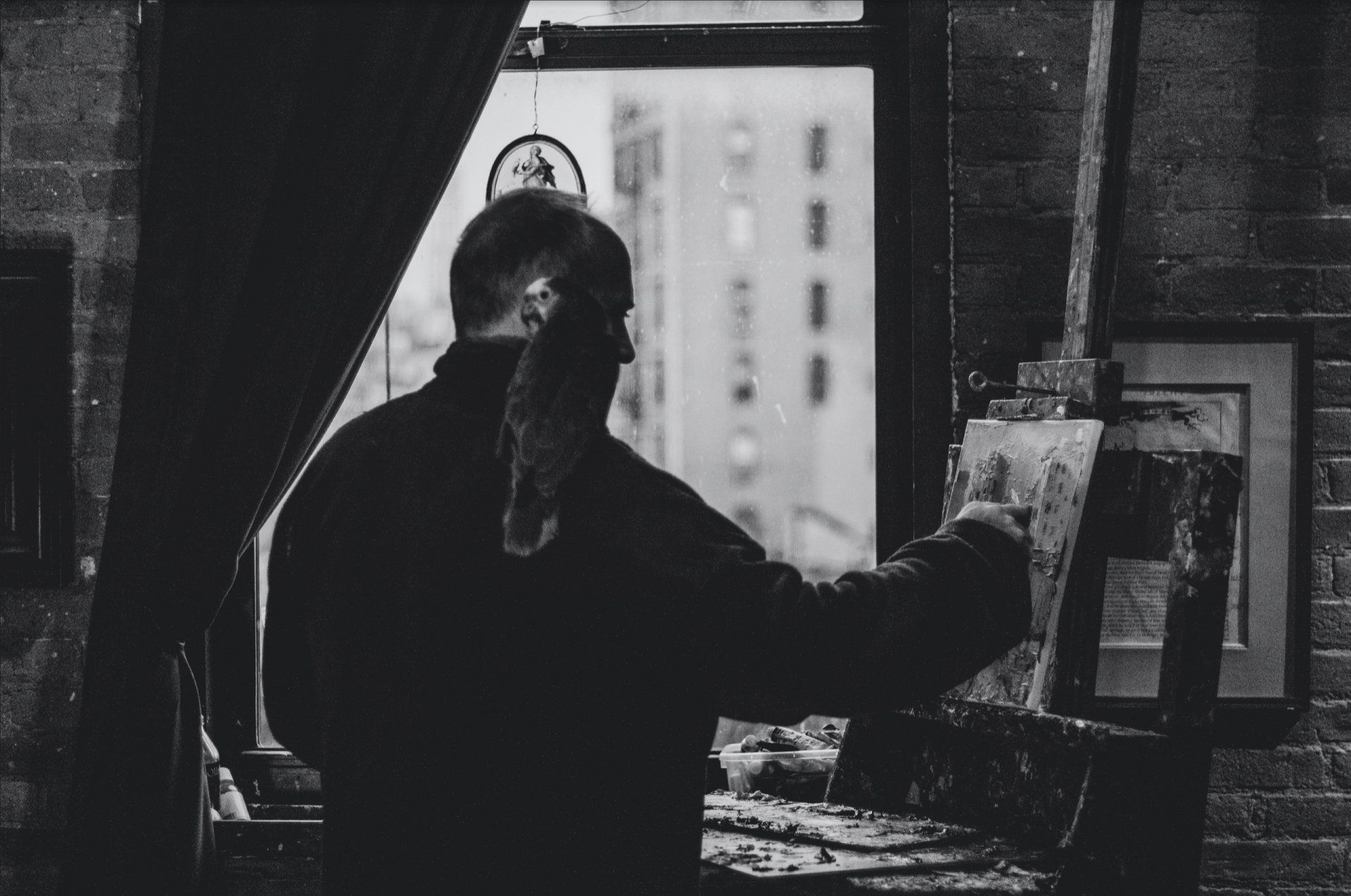Allen with Birdy
Photo by Sinclaire Yoon
ALLEN HIRSCH
(Los Angeles, b. 1959)
Allen Hirsch’s artistic talent revealed itself early on, as evidenced by the portraits he produced as a youth, including a remarkable likeness made at age fourteen of his childhood hero, J.R.R. Tolkien. After his first self-portrait was featured in a young talent exhibition in Washington’s National Portrait Gallery, Hirsch went on to study art at Camberwell in London, receive a B.F.A. from Syracuse University (1982) and a Masters of Art from Rosary College in Florence, Italy (1985). He rounded out his studies at Skowhegan (1985) and the New York Studio School (1986).
In 1982, Hirsch moved to New York City, and in these early years, experimented with different techniques, including painting only with a palette knife. Having lost his only job at Pearl Paint, he started showing his work on the street near the Whitney Museum. Among the passers-by who took notice of his paintings was Eugene Mihaesco, then one of the top illustrators for TIME. Mihaesco invited Hirsch to stop by the publication, which resulted in the artist doing covers for the magazine over the course of the next ten years. Among the more famous of these, one may cite: Muammar Qaddafi (1986), Ayatollah Khomeini (1987), “Kiki” Camarena (1989) and Rajiv Ghandi (1991). In 1986, Hirsch was asked to do a cover entitled DRUGS: THE ENEMY WITHIN. As he was going through a personal ordeal at the time, he decided to harness his own distress for the project and use himself as a subject. The result, an unnerving self-portrait seeping anguish, was the recipient of several awards.
Self Portraits
Hirsch’s work for TIME paved the way for him to paint William Jefferson Clinton’s inaugural portrait in 1993 for the National Portrait Gallery. A photograph from the period records the artist presenting the painting to the President at the White House, where the work subsequently hung for several years. In 1997, Hirsch was commissioned to paint a portrait of Luciano Pavarotti (La Scuola Collection) and opened the HP Gallery in Soho. Around this time, the artist also increasingly favored working in a “cube-like” manner “to submerge the image.”
By the late nineties, Hirsch was spending his summers in Venezuela and testing out new methods, including working in cement and on burlap. The artist also developed a technique called “string painting” that entails drawing or painting an image on a series of strings, which are separated to allow space between them and suspended over a backdrop. String painting enabled the artist to both break down and soften form, and to explore another aspect of spatial vision. In Hirsch’s words: “In string paintings, the eyes have to change the focus away from the strings themselves in order to perceive the image. This means blurring the strings and focusing behind them. As the perception of space is created by the eyes’ change of focus, this in effect, is creating space.”
Over the years, the artist has built strong friendships in Venezuela as well as a deep connection to the country’s fauna and flora. This has yielded a collection of paintings that not only speak of the artist’s love of Venezuela, but also of his finely-honed powers of perception and his understanding of seventeenth-century Dutch painting. Venezuela was also the site of Hirsch’s encounter with an orphaned capuchin monkey, who came to be known as Benjamin. The two developed an amazing bond, and their story has been related in an Emmy-winning documentary entitled “Long Live Benjamin” (2018).
His inventiveness in painting has led Hirsch to other creative pursuits. These include real estate development, such El Santuario de la Laguna, an eco-tourism complex in Venezuela, and patented products like HandL, a new way of holding cellphones, which is currently in Verizon and Staples stores. Hirsch also helped found La Esquina, a famous Mexican restaurant in Soho which has public art dedicated to Benjamin on view both within and outside the establishment.
Hirsch, who still resides in New York, is in the process of authoring several books and is a frequent contributor to the New York Times.



